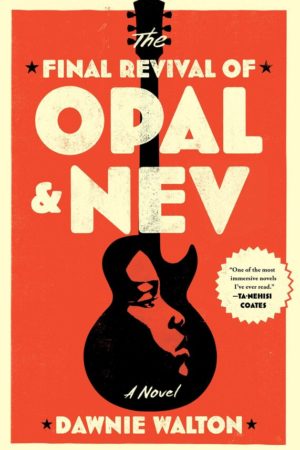The Final Revival of Opal & Nev
by Dawnie Walton
reviewed by Felice Arenas
When Grace Jones sings “I’ll find my way to you, no matter where” on her 1979 album Muse, she could be the titular Opal Jewel in Dawnie Walton’s The Final Revival of Opal & Nev—or describing its plot. A journalist named Sunny tracks down a music luminary, Opal, who knew her father best. But it’s not that simple (is rock ’n’ roll ever?). Structured as an oral history, this polyphonic debut not only examines the frayed familial ties that bind, but it also delves into the pervasive challenges Black performers faced in the ’70s and ’80s.
We first meet Sunny in 2016 and learn her father was a drummer named Jimmy Curtis. His former mistress is Opal, whom Sunny interviews in order to piece together her origins and contextualize Jimmy’s murder forty-five years earlier, months before she was born. Opal could be responsible. Sunny’s relentless inquiry couldn’t be more personal, but as editor-in-chief of music magazine Aural, she presents it as a professional assignment: Aural needs to run a feature story on a reunion concert (or “final revival”) featuring Opal.
Sunny’s investigation centers on when Jimmy performed with Opal & Nev, a biracial Afropunk duo, for the last time, and the novel seamlessly kicks back to 1970 to trace their rise to fame. Singing in a tradition of “dissidence and dissonance,” Opal arrives in New York after Nev, a sort of amalgam of David Bowie and Elton John, discovers her. It’s only after their much-publicized concert, dubbed “Altamont East”—when Lynyrd Skynyrd counterparts Bond Brothers brandish a Confederate flag to incite a deadly riot—that audiences notice the red-haired Brit and Dorothy Dandridge–esque, “ebony-
Initially, Sunny retreats from the love triangle between Opal, Jimmy, and her mother, Corrine. Soon, however, her intermittent “editor’s notes” shift from journalistic remove to grief to furious obsession with the Other Woman. Sunny learns that Jimmy’s attention was split between a traditional life with Corrine and an erotic odyssey with Opal, who wanted to remain childless. As Opal puts it: “[Jimmy] had to accept the woman I was, whatever wild ways I chose to show up.” We find this daughter simultaneously idolizing the by-all-accounts genius musician (“I wore out the record and admired it too, patting my palms on my thighs in time with my father’s rhythms … Wow, I thought, My dad did this”) and grappling with the revelation that he was a “philandering fool.” Yet Opal was his sole creative partner and ally in sparring with white record label managers, and Sunny feels sympathy for her as she traces the band’s opportunities and frustrations with the exploitative structures of the music industry. Opal & Nev reads like memoir and historical fiction, as Walton skillfully intermingles Sunny’s stakes in Opal’s private truth and Opal’s dedication to a public persona catalyzed during a storied era of music.
Deconstructing a father’s lover in neo-Freudian fashion makes for a compelling premise. Walton’s narrative taps the glass-encased enigma of Opal, the adulteress whom our protagonist justifiably resents, a feminist icon worthy of respect, no less, but it also transcends the ubiquitous tale of fame and fortune by going behind the music. Tensions between Black artists and the white industry players controlling their sound for profit make for a working relationship rife with distrust and discontent. Opal is perpetually not having it, but the hits must keep on coming. When asked in 1973 if she’s “nervous about the sentiment” she may be stirring up by her relationship to the Black Panther Party, Opal replies, “I got a better question for you. Why are you so deeply invested in proving I’m scared?”
It’s Opal we’ll remember from this work. Walton’s sketch feels at once familiar (Opal is boldly styled like pop pioneer Jones, and also Tina Turner and Whitney Houston), removed (because her achieved artistic success and subsequent celebrity isolates as much as it exalts her), and harrowing (as reactions to her decisions render a stranger fatherless, in search of an identity). Opal’s presence makes Corrine’s absence especially conspicuous; hers is the only unrecorded oral history, and the omission effectively amplifies the pain so many of these characters endure.
Walton’s prose reflects her professional background as a probing journalist: tonally impersonal. That is, until it’s not—and it’s at that distinct turn that the story gets going. When we’re not soaring through Opal’s highs, we’re immersed in Sunny’s catharsis. It’s important to better understand the risks Black artists took to shape radio back in the day and as we know it now. The Final Revival of Opal & Nev is complicated, but so is rock ’n’ roll. Sunny: “Isn’t that the story we should aim to be telling—how it is that this … music could reach a sheltered Black girl like me, and make her feel not just seen and heard, but empowered?”
Published on October 6, 2021

